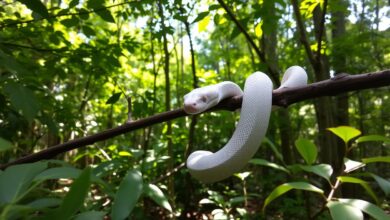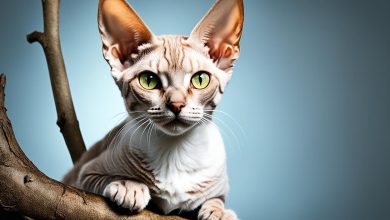Crested geckos can live up to 20 years in captivity. This makes them ideal for long-term exotic pet enthusiasts. These fascinating creatures offer low-maintenance care and captivating charm.
Crested geckos are known for their head crests and sticky feet. They typically reach 8-10 inches in length. These small lizards are perfect for both new and experienced reptile keepers.
Their size and docile nature make them easy to handle. They can thrive in smaller living spaces. Crested geckos are adaptable to room temperature environments.
These geckos require minimal special equipment. Their diet is simple, consisting of powdered food and occasional insects. This easy care has led to their rising popularity as exotic pets.
Crested geckos come in a range of color morphs. They have quirky personalities that charm their owners. A community of passionate gecko owners is ready to share experiences.
This guide will help you set up the perfect vivarium. You’ll learn to understand your gecko’s unique behaviors. Discover everything you need to know about these charming reptiles.
Introduction to Crested Geckos
Crested geckos, or Correlophus ciliatus, are captivating reptiles from New Caledonia. They’ve become popular pets since their 1994 rediscovery. These charming creatures offer unique companionship to reptile enthusiasts.
Origin and Natural Habitat
New Caledonian geckos thrive in their island’s lush forests. These tree-dwelling lizards prefer humid environments. Mimicking their natural habitat is crucial for their captive well-being.
Physical Characteristics
Crested geckos boast a distinctive crown-like crest from eyes to tail. Their specialized toe pads enable effortless vertical climbing. These features make them stand out among reptile pets.
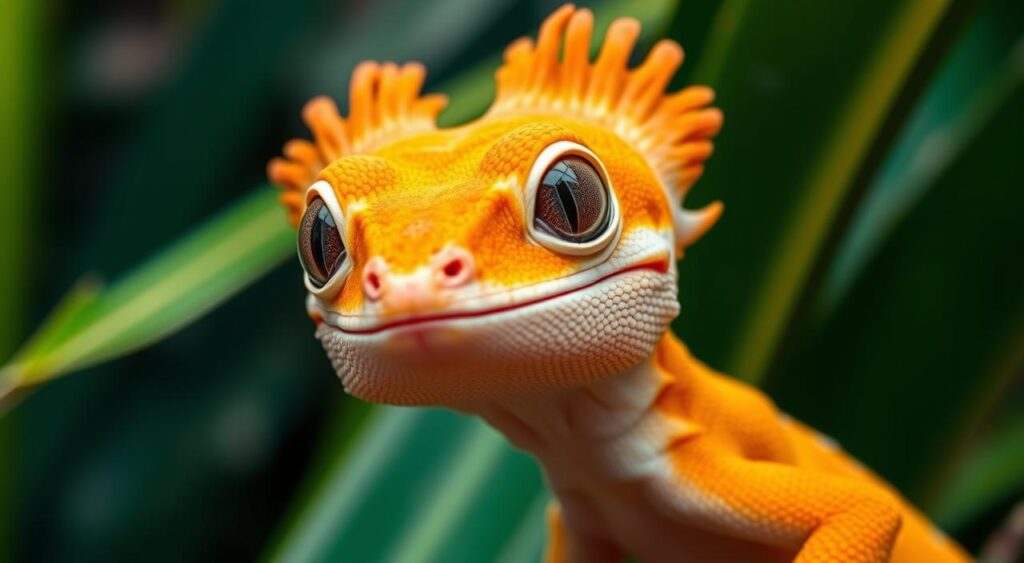
Lifespan and Size
Crested geckos can be long-term pets with proper care. They typically grow 5-8 inches long. With a lifespan of up to 20 years, they outlive many common pets.
| Characteristic | Measurement |
|---|---|
| Average Lifespan | 15-20 years |
| Adult Size | 5-8 inches |
| Minimum Habitat Size | 20 gallons |
| Temperature Range | 68-75°F |
| Ideal Humidity | 70-80% |
Why Crested Geckos Make Ideal Pets for Beginners
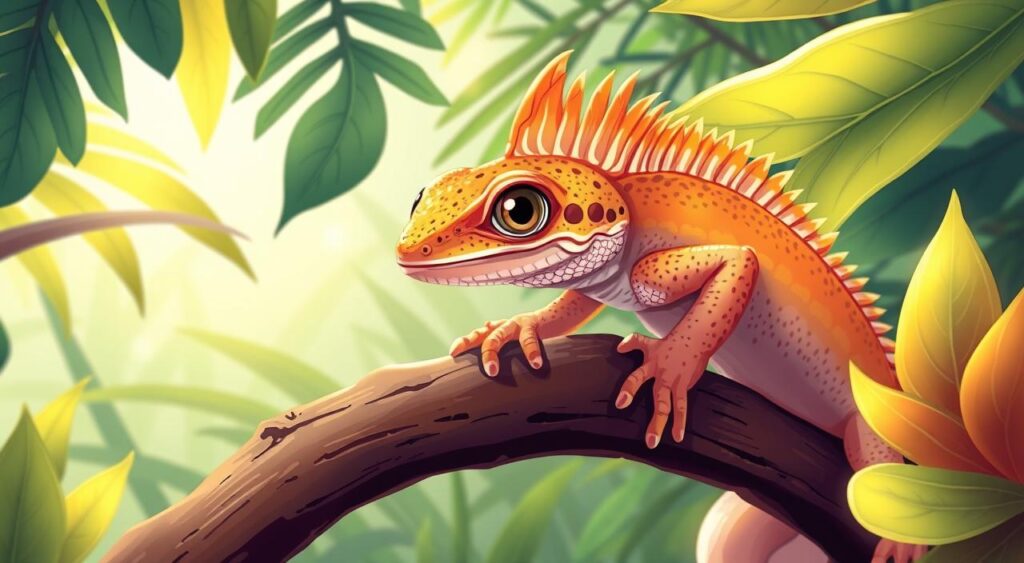
Crested geckos are top picks for new reptile owners. They’re easy to care for and fun to watch. These geckos offer a great start for those new to gecko care.
Adult crested geckos need only a 20-gallon terrarium. This makes them perfect for small homes or apartments. They’re compact, growing to just 8 to 10 inches long.
These geckos are budget-friendly pets. Initial costs range from $50 to $100. Total ownership expenses are between $400 and $600. Monthly care costs about $20.
- Low-maintenance care requirements
- No need for UVB lighting
- Diverse, easy-to-provide diet
- Crepuscular activity pattern
- Child-friendly nature
Crested geckos have a simple diet. They eat fruit-based powdered foods and occasional insects. Their small appetites make feeding easy for new owners.
These geckos are most active during twilight hours. This fits well with many people’s schedules. They’re also gentle, making them safe for kids over five to handle.
Crested geckos are great exotic pets for beginners. They’re unique and easy to care for. These geckos offer a fun intro to reptile pets without overwhelming new owners.
Setting Up Your Crested Gecko’s Home
A well-designed gecko habitat is vital for your pet’s health. It mimics their natural environment and encourages normal behavior. Let’s explore key aspects of terrarium setup for crested geckos.
Choosing the Right Terrarium
Crested geckos prefer vertical terrariums due to their tree-dwelling nature. An ideal enclosure for an adult measures 45x45x60cm. A larger 45x45x90cm size offers even more space.
Glass terrariums are best as they maintain proper humidity levels. They also allow easy viewing of your pet gecko.
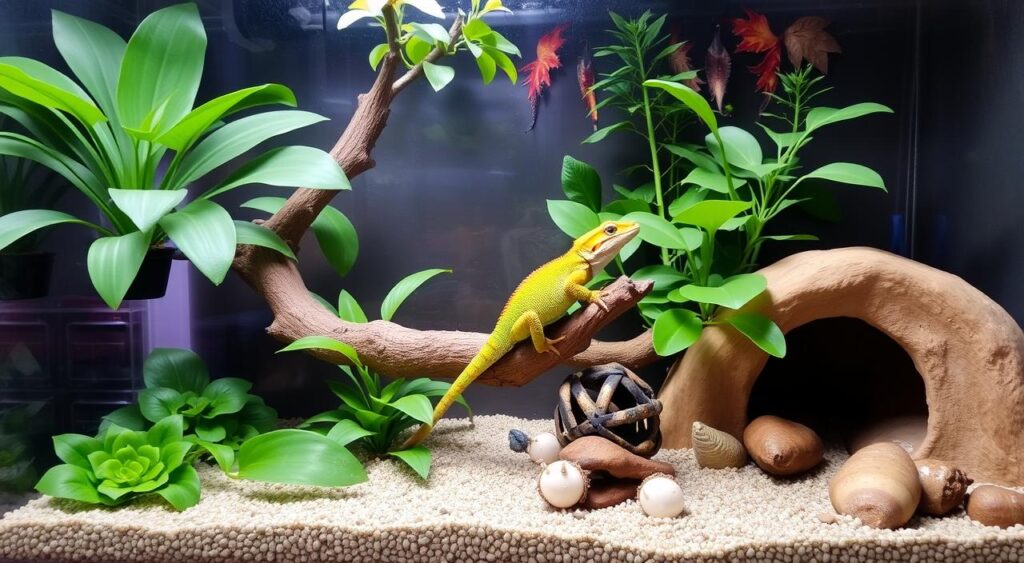
Essential Terrarium Accessories
Furnish your gecko’s home with climbing structures like branches and vines. Add hiding spots and feeding ledges to create a diverse setting. A digital thermo-hygrometer helps monitor temperature and humidity.
- Screen cover with clips
- Substrate (coconut fiber or reptile bark)
- Climbing structures (vines, branches)
- Lighting (UVB, daylight, and heat bulbs)
- Feeding dishes
- Misting system or spray bottle
Creating a Bioactive Vivarium
A bioactive vivarium offers a more natural gecko habitat. It includes live plants and helpful organisms like springtails and woodlice. This setup helps keep the enclosure clean and stimulates your crested gecko.
Keep daytime temperatures between 75-80°F and nighttime temperatures from 68-75°F. Maintain humidity levels between 60-80% for your gecko’s comfort. Your crested gecko will thrive with proper setup and care.
Crested Gecko Diet and Nutrition
A balanced diet is crucial for crested gecko care. These reptiles thrive on commercial powdered foods mixed with water. Brands like Pangea, Repashy, and Zoo Med offer complete nutritional options for crested geckos.
Insects are vital for reptile nutrition. Wild crested geckos eat beetles, caterpillars, and crickets. In captivity, offer crickets, Dubia roaches, or mealworms as treats. These protein-rich snacks support growth and provide enrichment.
Fruits add variety to a crested gecko’s diet. Offer ripe mango, banana, or papaya occasionally. In nature, fruits and nectar make up about 20% of their diet. Remember, fruits should be treats, not staples.
| Age | Feeding Frequency |
|---|---|
| Juveniles (0-12 months) | Daily |
| Adults | Every 2-3 days |
Check your gecko’s weight weekly to ensure proper nutrition. A healthy crested gecko maintains a steady weight. Provide fresh water daily, changing it every 2-3 days. This keeps your pet hydrated and healthy.
Handling and Socialization Techniques
Proper handling and socialization are crucial for crested gecko care. These intelligent creatures can form bonds with their owners. Trust-building is essential for successful interaction with these fascinating pets.
Getting Your Gecko Used to Handling
Begin by spending time near your gecko’s enclosure without interacting. This helps your pet get used to your presence. Slowly introduce short handling sessions, increasing their length over time.
Remember, each crested gecko has a unique personality. They all learn at different paces.
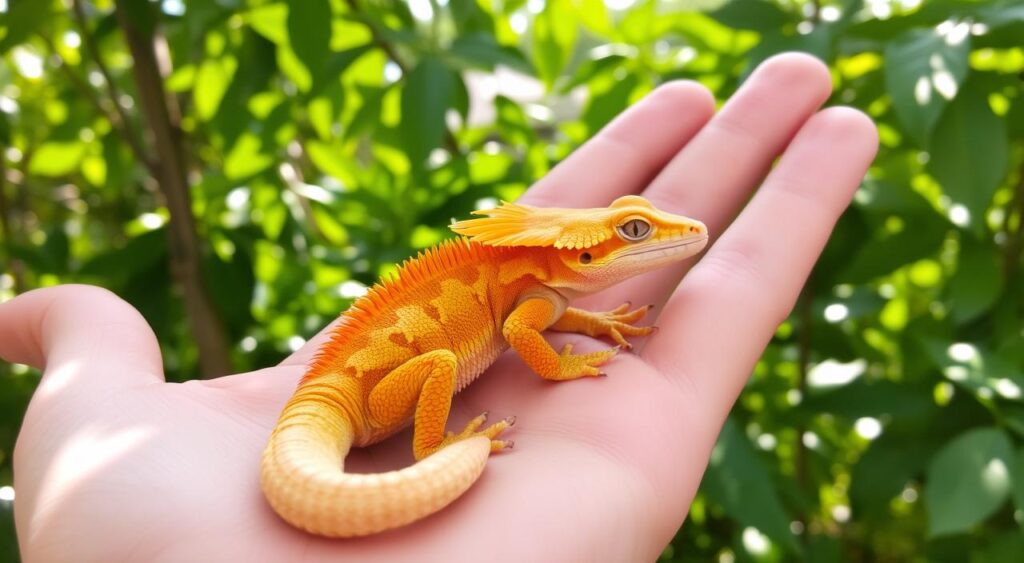
Safe Handling Practices
Always support your crested gecko’s body when handling. Avoid grabbing the tail. Adult geckos often become docile when treated gently.
Keep handling sessions short at first, especially for young geckos. This prevents stress and encourages positive associations with human interaction.
Building Trust with Your Pet
Consistency is key in building trust with your crested gecko. Use small treats as positive reinforcement during handling sessions.
These geckos may not respond to commands like dogs. However, they can learn to associate specific actions with cues. Regular, gentle interaction strengthens your bond.
“Crested geckos are intelligent creatures capable of forming strong bonds with their owners. Patience and gentle handling are key to fostering a trusting relationship.”
Training takes time and patience. As you improve your handling skills, caring for your gecko becomes more rewarding. This enhances your experience as an exotic pet owner.
Health Care and Common Issues
Proper gecko care is vital for keeping your reptile healthy. Crested geckos are tough but can face health problems in captivity. Regular check-ups help catch and prevent common issues early.
Metabolic bone disease (MBD) is rare in crested geckos with balanced diets. It usually comes from homemade or poor diets lacking calcium. Wavy tails in hatchlings don’t always mean MBD.
Impaction is a top health problem for geckos. It happens when they eat indigestible stuff like sand from their home. If not treated, impaction can be deadly.
Wrong tank temps can cause breathing problems. Shedding issues can lead to trouble if not fixed quickly.
- Floppy Tail syndrome: A cosmetic issue, not genetic
- Tail tip loss: Common due to hunting accidents or retained shed
- Internal parasites: Transmitted through contact or poor-quality food
Look out for signs your gecko needs a vet. These include breathing issues, thin tail, throwing up, or eye discharge. Quick action helps keep your scaly friend healthy.
| Health Issue | Cause | Prevention |
|---|---|---|
| Impaction | Ingestion of indigestible materials | Proper substrate selection |
| Respiratory infections | Inappropriate tank temperature | Maintain correct temperature gradient |
| Metabolic bone disease | Low calcium and vitamin D3 intake | Balanced diet with supplements |
Crested Gecko Morphs and Colors
Crested gecko morphs display an amazing range of colors and patterns. These variations make each gecko unique and exciting. Let’s dive into the world of crested gecko morphs and their genetics.
Popular Crested Gecko Morphs
Crested geckos come in various morphs with distinct traits. Some popular ones include:
- Dalmatian: Features spots on a solid background
- Harlequin: Displays intricate patterns on the sides and limbs
- Pinstripe: Exhibits raised, cream-colored scales along the back
- Flame: Shows contrasting colors on the head and dorsum
- Tiger: Presents dark vertical bands on the sides
Genetic Factors in Coloration
Crested gecko colors and patterns are determined by genetics. Four confirmed genetic morphs exist: Lilly White, Axanthic, Cappuccino, and Sable.
These genes influence the gecko’s appearance in different ways:
| Genetic Morph | Inheritance Pattern | Effect on Appearance |
|---|---|---|
| Lilly White | Incomplete dominant | Significant white or cream markings |
| Axanthic | Recessive | Lack of yellow pigmentation |
| Cappuccino | Incomplete dominant | Coffee-like coloration |
| Sable | Incomplete dominant | Dark, rich coloration |
Choosing Your Gecko’s Morph
Think about your likes and breeding goals when picking a crested gecko morph. Some morphs, like Lilly White, are popular in the pet trade.
Others, such as the Halloween morph, offer unique black and orange colors. Remember, every gecko is special, no matter its morph.
Breeding Crested Geckos: What You Need to Know
Gecko breeding fascinates enthusiasts. Success hinges on understanding key factors in crested gecko reproduction. Let’s explore the essentials of this exciting venture.
Male crested geckos mature sexually around 6-9 months. They develop a hemipenile bulge between 5-10 months. Males should weigh at least 20-25 grams before mating.
Female geckos start laying eggs at about one year old. They typically weigh 25-35 grams when ready to breed.
Mature females lay two eggs every 25-40 days. They usually produce 7-9 clutches before taking a break. Females can retain sperm for an entire breeding season.
Crested gecko morphs are crucial in breeding. Outstanding males can pass genes to many offspring. This makes them valuable for breeders seeking specific traits.
| Breeding Factor | Details |
|---|---|
| Male Maturity | 6-9 months, 20-25 grams |
| Female Maturity | 1 year, 25-35 grams |
| Egg Laying Frequency | 2 eggs every 25-40 days |
| Incubation Period | 60-90 days (average 70-75 days) |
| Incubation Temperature | Mid 70s Fahrenheit |
Proper incubation is vital for successful gecko breeding. Eggs typically hatch after 60-90 days. The average incubation period is 70-75 days.
Maintain temperatures in the mid-70s Fahrenheit for best results. Use perlite as an incubation medium. Mix perlite with water in a 1:1 or 1:2 ratio.
Crested Gecko Behavior and Activity Patterns
Crested geckos have unique behaviors that are vital to understand. These reptiles are most active during twilight hours. Knowing their habits helps provide better care for these fascinating creatures.
These geckos often cling to favorite perches in their enclosures. This behavior reflects their natural instincts. Changes in activity can signal health issues or environmental problems.
Crested geckos show interesting behaviors that reveal their personalities. Some eat their shed skin to reclaim nutrients. Tail wagging is common when they feel threatened or want to communicate.
These reptiles can make chirps and squeaks. The reasons for these sounds are still unclear. Unusual behaviors rarely need immediate concern, but staying alert ensures your gecko’s well-being.
| Behavior | Description | Significance |
|---|---|---|
| Perching | Clinging to preferred spots | Natural instinct, comfort |
| Skin eating | Consuming shed skin | Nutrient retention |
| Tail wagging | Moving tail side to side | Communication, defense |
| Vocalizations | Chirps and squeaks | Possible territorial or defensive signals |
Crested geckos can handle brief interactions but prefer limited contact. Be careful to avoid causing tail shedding, a natural defense. Understanding these behaviors will help you care for your scaly friend better.
Comparing Crested Geckos to Other Reptile Pets
Exotic pet enthusiasts often consider various reptile options. Crested geckos offer unique advantages over popular choices like leopard geckos and bearded dragons. Let’s explore what makes these captivating creatures stand out.
Crested Geckos vs. Leopard Geckos
Crested and leopard geckos differ in habitat preferences. Crested geckos thrive in vertical spaces, while leopard geckos prefer ground-level environments. This affects their enclosure needs and daily routines.
| Feature | Crested Gecko | Leopard Gecko |
|---|---|---|
| Size | 7-9 inches | 7-10 inches |
| Weight | 10-11.5 ounces | 7-2.6 ounces |
| Lifespan | 10-20 years | 15-20 years |
| Diet | Insects, fruits, specialized food | Insects (crickets, mealworms) |
| Enclosure | Vertical | Horizontal |
Crested Geckos vs. Bearded Dragons
Crested geckos need less space than bearded dragons. They’re perfect for smaller homes. Their diet is simpler, and they don’t need UVB lighting.
Advantages of Crested Geckos as Pets
Crested geckos are low-maintenance pets with minimal care needs. Their gentle nature makes them easy to handle. They’re great for beginners and kids learning about lizard care.
Crested geckos come in many unique color variations. This appeals to enthusiasts looking for one-of-a-kind pets.
“Crested geckos are recommended for novice reptile owners and children learning to care for lizards.”
Crested geckos are exceptional reptile pets. They’re easy to care for and have fascinating traits. These geckos are an excellent choice for both new and experienced exotic pet owners.
Join the Crested Gecko Community
Crested geckos make exciting exotic pets. Joining their community opens doors to knowledge and support. Online forums buzz with discussions on habitat setup and breeding techniques.
Expert keepers share insights on cohabitation and enclosure designs. You’ll learn about different housing arrangements and their pros and cons. The community helps new owners tackle challenges like preventing aggression.
Engaging with other fans can boost your pet care skills. You’ll find tips on monitoring health and optimizing breeding conditions. The community offers a supportive space to grow your expertise.
Explore topics from basic husbandry to advanced morph development. Discover the fascinating world of genetic traits in crested geckos. Join this vibrant community and deepen your passion for these charming reptiles.



